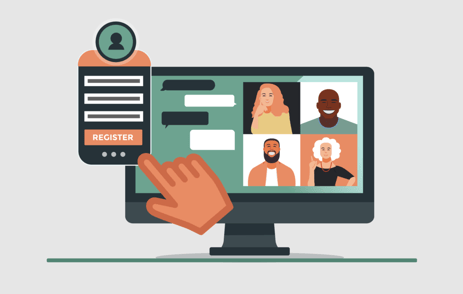The shift to online meetings has exposed a number of weaknesses in how we present material.
Public speaking isn’t easy at the best of times but the new considerations that accompany a Zoom reality are sabotaging even seasoned pros. Bad lighting, a loss of personal connection, and a flat screen interface may seem impossible to overcome, but there is hope for anyone committed to shaking things up and re-engaging with their online colleagues. The best part is, you’ve already done it before.
Show and Tell
It’s called show and tell, the first presentation exercise most children practice at school. Think back to kindergarten and the excitement you felt at bringing in something special to show your friends. You were expected to talk about an item of your choice and explain to your classmates why it appealed to you. Doesn’t that sound like the fun version of every book report, science project, or office brief that you have ever given? Well, there is no reason why it cannot continue being fun.
Set up
The only way to hold an audience’s attention is to make sure that you control centerstage. It may come as a surprise, but Zoom’s digital interface transforms you into a performer. Accept it and set the arena so nothing competes with you for attention. The easiest solution is to use an LED light that shines directly onto your face, almost like the front light of a theatre. As much as people love clever backdrops -- such as Game of Thrones or a sandy beach -- unless you are hosting a birthday party, keep it simple and clean.
Rehearsal
Schedule a Zoom appointment with a trusted colleague or friend days in advance of a Zoom presentation and practice what you plan to say. Remember to have water on hand and to articulate so your words don’t get swallowed. Your goal is to deliver a message with clarity so your listeners are able to hear you without struggling. Remember to breathe. When you breathe and open your mouth, the sound flows freely. Ask your practice buddy for feedback and record your Zoom session so that you can assess your performance.
Establish the order in advance.
If you are moderating a meeting, request that each participant mute themselves to prevent aural interference. Then give a signal to whomever you plan to call upon by first calling their name, then asking the question, and finally adding a button such as, “What do you think about that?” This way you can avoid awkward silences or lulls. If you are not moderating, ask for an agenda ahead of time so you are not caught unaware.
Awkward silences and movement breaks
They are bound to happen. The best way to avoid them is to suggest that participants take a break. For instance, “While person B thinks about that, why don’t we all take a moment to stretch.”. Your audience will thank you for keeping them on their toes.
Interruption in transmission
If there is a delay caused by a weak internet signal, do not panic. Acknowledge the issue but avoid losing momentum. Move the agenda forward, or jump back to a previous point that could use additional development. If the interruption persists, give attendees a five minute break while you resolve the technical issue. Do not leave attendees squirming in their seats. Give them the opportunity to step away. And cover your camera while solving this problem so the only image that viewers see is one of you in control.
Move the agenda
Let people know that no more than two minutes will be devoted to each response. This is particularly important when speaking to large audiences. There is no virtue in watching a person ramble. Succinct answers keep the audiences engaged because most people only care about the why and the what. The how can be saved for one-on-one conversations, particularly during Q&A sessions. If further clarification is requested, that is fine. Just keep in mind, audiences do not like to feel like they are being held hostage.
Maintain order
If you are moderating, make sure you have someone on hand to help mute or remove trouble makers. Before you begin a session, let panelists know you will interrupt them if they go over their speaking time. This is essential. Nothing slows down a meeting more than someone who refuses to stop speaking. While hosting a panel with a former employer, I muted him and then turned off his video midway through a rambling speech. I messaged him an explanation afterwards, but the audience was relieved we were able to get back on track.
Keep it sexy
No one wants to watch you read a science report. This is particularly true at medical or science conferences. If attendees can read the paper for themselves, let them. Take the most important points and deliver them with a smile. Ask participants to write down their thoughts so they can take a moment to reflect on what you have shared. Take a chance and call on a specific person to respond to something you’ve explained. This way you can gauge how it has landed. If a point is not getting across, change your explanation tactics and then move on. Have someone planted in a meeting to send you a text or private chat message if you are losing the audience’s attention. Remember: the goal is to leave them wanting more, not feeling bored.
Begin and end on time
Starting on time is a mark of professionalism. Even if things are not perfect, it is preferable to begin proceedings than to leave attendees stranded in the waiting room. Have an alternative feature available to engage the audience in case of a delay. End on time even if you do not finish your entire agenda and have the option for overtime available so that anyone who wishes to remain can do so. Most attendees are running from your Zoom to another. Ending on time means that everyone can depart feeling relieved that they were in your capable hands.
These tips are sure to keep you on task and in charge of your Zoom presentation. The most important thing to remember is that you’ve been doing this since you were a child. With a little practice you can do it again, with aplomb.
Tags:
Events Management
June 18, 2020


